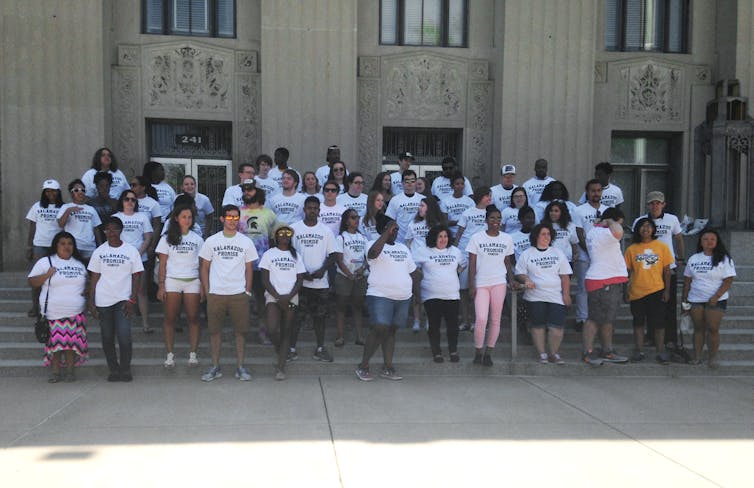

Laura Perna, University of Pennsylvania; Edward J. Smith, University of Pennsylvania, and Elaine W. Leigh, University of Pennsylvania
In one of her first public acts as the new mayor of Seattle, Jenny Durkan signed an executive order last month to phase in a free college tuition program. The program promises up to two years of free tuition at a Seattle community or technical college for recent graduates of Seattle’s public high schools.
The Seattle Promise College Tuition program is part of a growing “college promise movement.” More than 200 free college promise programs now operate in 42 states, and many of these programs were created in the last few years.
Proponents say that these programs will reduce the financial barriers to college and help more people get the education and training they need to get the jobs of today and tomorrow.
But will free college programs achieve their promise? Can they make college more affordable and increase college attainment? The answers to these questions depend on how programs are designed and structured – as well as whether they are financially sustainable.
Gaining a clearer picture
Over the past two years, our research team at the University of Pennsylvania has been examining the characteristics of free college promise programs in states and communities across the nation. In an effort to compile, organize and share information about new and more established college promise programs, we created an online searchable database. We focus on programs that seek to increase college enrollment, provide financial assistance, and benefit students who live in a particular state, city or community or who graduate from a particular school district.
Programs may be more effective when they are designed to meet the needs of the specific community or state. These are what Michelle Miller-Adams, Brad Hershbein and others at the W.E. Upjohn Institute for Employment Research call “place-based scholarship programs.” Place-based scholarship programs not only seek to increase college participation. They also try to create a college-going culture in K-12 schools and encourage economic development. Place-based scholarship programs are modeled after the Kalamazoo Promise, created in 2005, and include other relatively long-standing initiatives like the El Dorado Promise and the Pittsburgh Promise.
The Kalamazoo Promise, in particular, has been shown to increase college participation and degree attainment. But just because Kalamazoo achieved these results doesn’t mean other programs will. Unlike some other programs, the Kalamazoo Promise provides a generous financial award, allows students to use that award at many two-year and four-year colleges and universities and is designed to build a college-going culture that starts in kindergarten. Other programs may not have all those things.
Free college promise programs will not improve college affordability or increase college degree attainment unless they are financially sustainable. Programs that have a dedicated financial source, such as Tennessee Promise’s endowment, may be more financially stable than programs that rely on philanthropic donations or annual appropriations, such as the Oregon Promise. Six years after it was created in 2009, a “promise zone” in Jackson, Michigan, was dissolved because the city could not raise the $2.1 million needed to make the college scholarship program viable by 2015.
The same year, the Tennessee Promise emerged. This program covers tuition and fees for eligible Tennessee high school graduates who attend an eligible in-state community college or a Tennessee technology center to earn an associate degree, diploma or certificate.
Tennessee is not alone. Legislatures and governors in at least 14 other states – including Oregon, Rhode Island, Minnesota and New York – have also established free college promise initiatives.

Mike Householder / AP
Located across the nation, free college promise programs have different participation requirements and use different approaches to award financial assistance. They also place different restrictions on the postsecondary education institutions where eligible students may use an award.
Some differences may reflect the trade-offs that are necessary when money is limited. Some programs, for example, provide small average dollar awards to many students. Other programs offer larger awards to fewer students.
Many programs offer last-dollar awards to pay tuition and fees that are not covered by other federal or state grant programs. Programs that provide last-dollar awards will provide larger average awards to students from higher-income families than to those from lower-income families. This is because students from lower-income families will have their award reduced by the amount of need-based federal and state aid they receive.
The longer-term cost of last-dollar programs may be hard to control or predict, because last-dollar awards depend on funding for federal and state financial aid. The cost of programs that link awards to tuition and fees will also increase as tuition and fees rise. Programs should also recognize the other costs of attending college. These costs include room and board, books and supplies, transportation and childcare. The costs also include the money that students don’t earn when they go to class instead of work.
More than just affordability
College promise programs should not be judged only for how they improve college affordability. If we do that, we will miss the other ways that these programs might improve attainment – and the ways that these programs might be different from traditional student grant programs. Programs may also provide services that help students with other things that matter to attending and graduating college, such as advising and academic support.
Research suggests the benefits of encouraging K-12 schools and colleges to work together so that students can move from K-12 schools into college without the need for “remedial” education. Two-year and four-year colleges and universities should also collaborate to enable students to transfer between institutions without losing any credits. The colleges and universities that promise recipients attend must also have the resources to provide high-quality education and support students through program completion.
![]() The Seattle Promise College Tuition Program is expected to build on the existing 13th Year Promise Scholarship, a program funded by private donors and businesses. The details of how the new program will be funded have not yet been determined. If this and other free college promise programs are to create meaningful improvements in college attainment, then figuring out how to address college affordability as well as other barriers will be essential. Equally important, if not more, will be ensuring long-term financial sustainability.
The Seattle Promise College Tuition Program is expected to build on the existing 13th Year Promise Scholarship, a program funded by private donors and businesses. The details of how the new program will be funded have not yet been determined. If this and other free college promise programs are to create meaningful improvements in college attainment, then figuring out how to address college affordability as well as other barriers will be essential. Equally important, if not more, will be ensuring long-term financial sustainability.
Laura Perna, Professor of Higher Education, University of Pennsylvania; Edward J. Smith, PhD Candidate, Higher Education, University of Pennsylvania, and Elaine W. Leigh, PhD Candidate, Higher Education, University of Pennsylvania
This article was originally published on The Conversation. Read the original article.



















